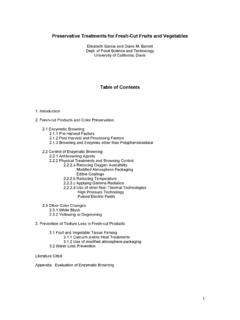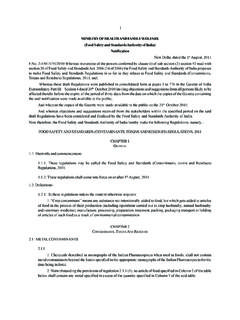Transcription of Fruit and Vegetables for Health - WHO
1 Fruit and Vegetables for HealthReport of a Joint FAO/WHO Workshop,1 3 September 2004, Kobe, JapanWHO Library Cataloguing-in-Publication DataJoint FAO/WHO Workshop on Fruit and Vegetables for Health (2004 : Kobe, Japan) Fruit and Vegetables for Health : Report of a Joint FAO/WHO Workshop,1-3 September, 2004, Kobe, Health policy : 92 4 159281 8 (NLM Classification: WB 430)Cover design and layout: Printed in the creditsFruit and Vegetables for HealthReport of a joint FAO/WHO workshop1-3 Sept 2004, Kobe, JapanCover: UNECE, WHO/P. VirotInterior Pages: p. 3 UNECE, p. 4 WHO/P. Virot, p. 6 WHO/P. Virot, p. 7 Baudoin, p. 8, 9, 11, 12 UNECE, p. 15, 16 WHO/P. Virot, p. 18 , p. 19, 20 UNECE, p. 22 Baudoin, FAO/W. Baudoin, p. 27 FAO/W. Baudoin, p. 31 WHO/A. Waxman, p. 33 UNECE, p. 35 PAHO.
2 Baudoin,p. 37 UNECE, p. 41 WHO/P. Virot, p. 43 WHO/P. Virot,p. 45 UNECE. World Health Organization and Food and Agriculture Organization of the United Nations 2005 All rights reserved. Reproduction and dissemination of material in this information product for educational or other non-commercial purposes areauthorized without any prior written permission from the copyright holders provided the source is fully acknowledged. Reproduction of material inthis information product for resale or other commercial purposes is prohibited without written permission of the copyright holders. Applicationsfor such permission should be addressed either to the Chief, Publishing Management Service, Information Division, FAO, Viale delle Terme diCaracalla, 00100 Rome, Italy (or by e-mail to or to Publications, World Health Organization, 20 Avenue Appia, 1211 Geneva 27,Switzerland (fax: +41 22 791 4806; email: ).)
3 Publications of the World Health Organization can be obtained from Marketing and Dissemination, at the above address(tel: +41 22 791 2476; fax: +41 22 791 4857; email: designations employed and the presentation of the material in this publication do not imply the expression of any opinion whatsoever on thepart of the World Health Organization or of the Food and Agriculture Organization of the United Nations concerning the legal status of any country,territory, city or area or of its authorities, or concerning the delimitation of its frontiers or boundaries. Dotted lines on maps represent approximateborder lines for which there may not yet be full mention of specific companies or of certain manufacturers products does not imply that they are endorsed or recommended by the WorldHealth Organization or by the Food and Agriculture Organization of the United Nations in preference to others of a similar nature that are notmentioned.)
4 Errors and omissions excepted, the names of proprietary products are distinguished by initial capital World Health Organization and the Food and Agriculture Organization of the United Nations do not warrant that the information contained inthis publication is complete and correct and shall not be liable for any damages incurred as a result of its publication contains the collective views of an international group of experts and does not necessarily represent the decisions or the statedpolicy of the World Health Organization or of the Food and Agriculture Organization of the United Overview of Health effects of Fruit and Vegetables -regarding cancer, CVD, obesity and Trends in Fruit and vegetable consumption and effects as part of the nutrition Worldwide production of Fruit and Measuring intake of Fruit and Effectiveness of interventions and programmes promoting Fruit and vegetable Production interventions to improve the availability of and access to Fruit and Vegetables for A global initiative on Fruit and Vegetables : FAO s interdisciplinary approach to the promotion of Fruit and Vegetables Meeting consumers needs and preferences for Fruit and Food safety aspects in Fruit and Patterns and determinants of Fruit and vegetable demand in developing countries.
5 A multi-country Country case study ThailandWorkshop ConclusionsA framework for promoting Fruit and Vegetables at national Guiding principles for a Fruit and vegetable Consumer domains and Fruit and vegetable supply Characteristics of consumer domains and Fruit and vegetable supply Entry points for Fruit and vegetable promotion Barriers to Fruit and vegetable Identification of National coordinating Constitution of national coordinating Roles of national coordinating Identification of national goals and Considerations regarding goal-setting Activities at national Existing national policies and action Possible interventions at national Sources of data and data Monitoring and evaluationAnnex 1 ParticipantsAnnex 2 Workshop agenda7899101011121314151617182123232428 2930313738404412345 Content7 BackgroundNoncommunicable diseases (NCDs), especially cardiovasculardiseases (CVDs), cancer, obesity and type 2 diabetes mellitus,currently kill more people every year than any other cause of factors in the epidemiology of these diseases poor diet, physicalinactivity, tobacco and alcohol use are of overwhelming importanceto public Health .
6 Fruit and Vegetables are an important component of a healthy diet and,if consumed daily in sufficient amounts, could help prevent majordiseases such as CVDs and certain cancers. According to The WorldHealth Report 2002, low Fruit and vegetable intake is estimated tocause about 31% of ischaemic heart disease and 11% of it is estimated that up to million lives couldpotentially be saved each year if Fruit and vegetable consumption wassufficiently increased. Recommendations in this direction tend tocomplement and reinforce other valid messages based on the long-known Health benefits of consuming Vegetables and Fruit as dietarysources of fibre, vegetable proteins and protective micronutrients. Therecent Joint FAO/WHO Expert Consultation on diet, nutrition and theprevention of chronic diseases, recommended the intake of aminimum of 400g of Fruit and Vegetables per day (excluding potatoesand other starchy tubers) for the prevention of chronic diseases suchas heart disease, cancer, diabetes and obesity, as well as for theprevention and alleviation of several micronutrient deficiencies,especially in less developed recommendation thusadds to the already strong case for the Health benefits to be gainedfrom the consumption of Fruit and Vegetables and paves the way forconcrete action advocating increased consumption of thesecommodities.
7 WHO has responded to the global rise in NCDs by giving increasingattention to their prevention and control, most recently through theGlobal Strategy on Diet, Physical Activity and Health endorsed at theFifty-seventh World Health Assembly on 22 May theframework of this Global Strategy, WHO aims to actively promote anincrease in Fruit and vegetable intake worldwide. To reach this goal,WHO and FAO have formed a partnership around the theme of fruitand Vegetables for and FAO announced their joint effort at the Third Global Forumon NCD Prevention and Control held in Rio de Janeiro, Brazil, inNovember 2003, emphasizing that worldwide awareness of the healthbenefits of Fruit and vegetable consumption needs to be increased. Inaddition, accelerated national initiatives are required to produce andefficiently market more affordable horticultural products, whileensuring that they are safe and that fewer losses occur along the post-harvest handling and FAO held their first joint workshop Fruit and Vegetables for Health at the WHOC entre for Health Development in Kobe, Japan,on 1-3 September 2004.
8 Participants includednutrition, Health and agricultural scientists,representatives from ministries of Health andagriculture, advisers on nutrition from WHOR egional Offices, experts from the World FoodProgramme, the United Nations EconomicCommission for Europe, the Secretariat of thePacific Community, the International FoodPolicy Research Institute, and the global "5 ADay" community, which promotes Fruit andvegetable consumption (see Annex 1 for thelist of participants and Annex 2 for theworkshop programme). The overall goal of the workshop was todevelop a draft framework to guide thedevelopment of cost-efficient and effectiveinterventions to promote adequateconsumption of Fruit and Vegetables inMember States. The expected outcomes of theworkshop were a series of background papersprepared by experts (and published inseparate documents, available , andthe elaboration and endorsement byparticipants of a draft framework to guideeffective Fruit and vegetable promotioninterventions at national level, taking the wholechain from production to consumption intoaccount ( production, trade, post-harvesthandling, processing, distribution, marketing,procurement, preparation and consumption offruit and Vegetables ).)
9 Presentations of the background papers andcase studies from selected countries aresummarized in section 3 of this report. Thepoints and arguments raised by participants11 The World Health Report, Reducing risks, promotinghealth. Geneva, World Health Organization, 2002. 2 Diet, nutrition and the prevention of chronic of a Joint FAO/WHO Expert ,World Health Organization, 2003 (WHO Technical ReportSeries, No. 916).3 Available from: 82during the discussion are included in text boxes in Section 3. Whilethese do not reflect the opinion of WHO or FAO, nor the workshopparticipants overall, they are included to reflect the rich discussionand different points of view raised during the workshop. Theconclusions of the workshop are summarized in Section 4 and Section5 contains the draft workshop was financially supported by the WHO Kobe Centre forHealth Development.
10 FAO's support for the participation of a numberof agriculture and horticulture experts from Africa, Asia and LatinAmerica was supplemented by contributions from ongoing nationalprogrammes - Special Programme on Food Security and others - inGhana, Nigeria, Thailand, and Venezuela, from the AgriculturalScience Foundation, India and also from programmes funded byBelgium, DANIDA (Denmark) and addressThe Director of the WHO Centre for Health Development (WKC), DrWilfried Kreisel opened the workshop. He stressed that the workshopwas an excellent opportunity for the two UN agencies to join hands andconsequently to have a stronger impact on the Health outcomes ofcorresponding policies, programmes and activities of the MemberStates. He reminded the participants that WHO had identified low fruitand vegetable intake as one of the top 10 risk factors contributing tomortality, and that adequate Fruit and vegetable consumption couldhelp prevent major chronic NCDs.















